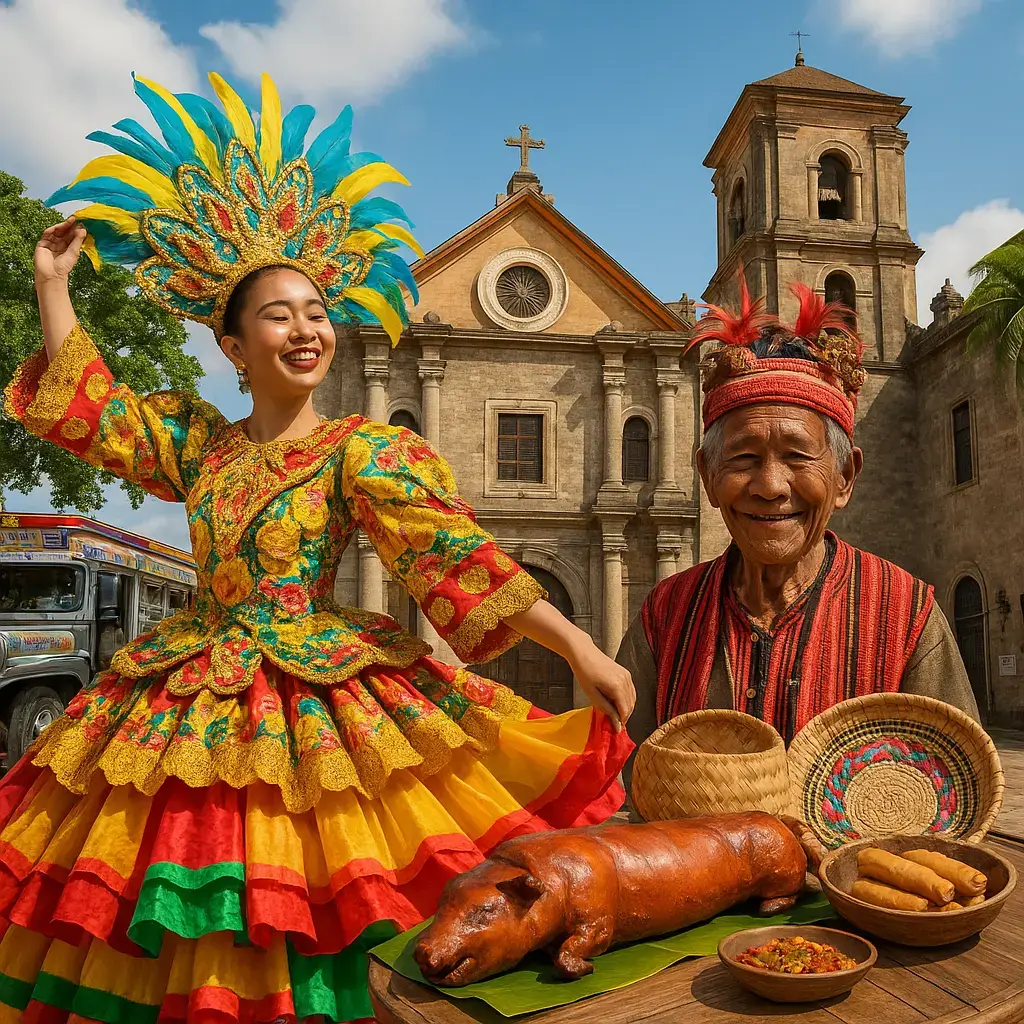
Filipino Heritage – A Tapestry of Time — The Historical Roots of the Filipino Soul
Spoiler: It’s older, deeper, and more dramatic than your favorite telenovela.
Before the Colonizers Came to Ruin Everything: Indigenous Brilliance

Long before Magellan showed up with his shiny boats and even shinier ego, the Philippines was already vibing, the Filipino heritage was alive and going strong.
- Up north, the Ifugao were casually carving staircases into mountains, a.k.a. the Banaue Rice Terraces. These weren’t just for planting rice. They were spiritual spaces where nature got front-row seats to every harvest ritual. If ancient agriculture had an Oscars, this was Best Picture.
- Down in the Visayas, folks sailed around in balangay boats like Southeast Asia’s answer to Moana. They ran their barangays—mini-countries run by a datu who was equal parts ruler, warrior, and community therapist.
- Meanwhile, in Mindanao, the Maranao and Tausug were showing off with jaw-dropping okir designs, kulintang gongs, and more oral epics than your cousin with a podcast. These weren’t just arts and crafts, they were spiritual TED Talks.
Indigenous Filipinos lived close to the land, celebrated everything from planting rice to catching fish, and built societies that worked just fine—until, well…
Enter Spain: 333 Years of Conquest, Catholicism, and Confusing Surnames
The Spaniards landed in the 1500s, looked around, and decided everything needed a church and at least three processions. Cue 333 years of “improvement.”
- They brought Catholicism. Filipinos brought the tambourines. Result? Sinulog!
- They built stone churches. Filipinos still managed to make them feel like home—with side altars to saints and the local diwata. Multitasking, baby.
- They introduced the encomienda system. Basically, the original “Land Grab 101.” Not cute.
Yet, Filipinos didn’t just roll over. They fused native rituals with Catholic fiestas, gave their babies Spanish names while still whispering to the anitos, and kept dancing. They blended their Filipino heritage with the Spanish additions.
Also, meet the mestizo class—part Spanish, part native, 100% the reason everyone in Filipino teleseryes looks suspiciously good in both barong and baroque.
Americans Take Over: Education, Burgers, and Basketball
The U.S. waltzed in after beating Spain, like someone crashing a party and immediately changing the playlist.
- English became the default language. So now, Filipinos can switch from Shakespeare to street slang without blinking.
- Public education spread fast. Suddenly, every Filipino knew the capital of Nebraska.
- Basketball courts popped up everywhere. It’s not a hobby—it’s a national religion with slam dunks.
But it wasn’t all spelling bees and three-pointers. Filipinos wanted independence. Badly. Enter: revolutions, heroes, declarations, and eventually, in 1946, freedom. Sort of. Once again, they merged their Filipino (and Spanish) heritage with the new American changes.
The result? A beautifully weird cultural combo: part La Solidaridad, part Sesame Street. And somehow, it works.
The Melodies of Tradition — Music, Dance, and Art
Yes, we’ve got rhythm—and then some.
Kulintang, Gangsa, and Nose Flutes: Indigenous Beats That Slap

The Philippines didn’t need Spotify to drop hits.
Long before earbuds and Bluetooth speakers, Filipinos were jamming with kulintang gongs, bamboo flutes, and instruments you’ve never heard of but want to.
- Kulintang – Think of it as the xylophone’s cool gong cousin. Played by the Maranao and Maguindanao, this horizontal masterpiece handles everything from love songs to spiritual rituals.
- Gangsa – A flat gong from the Cordilleras, perfect for weddings, funerals, and showing off during community dance-offs.
- Tongali (nose flute) – Yes, you read that right. It’s a flute. You play it with your nose. Try not to giggle while someone serenades you with it, it’s romantic in a very nasal way.
These instruments aren’t just musical instruments, they’re ancestral walkie-talkies. They connect generations and bring entire communities into sync; one gong beat at a time.
Dancing with Spirits (and Occasionally Between Bamboo Sticks)
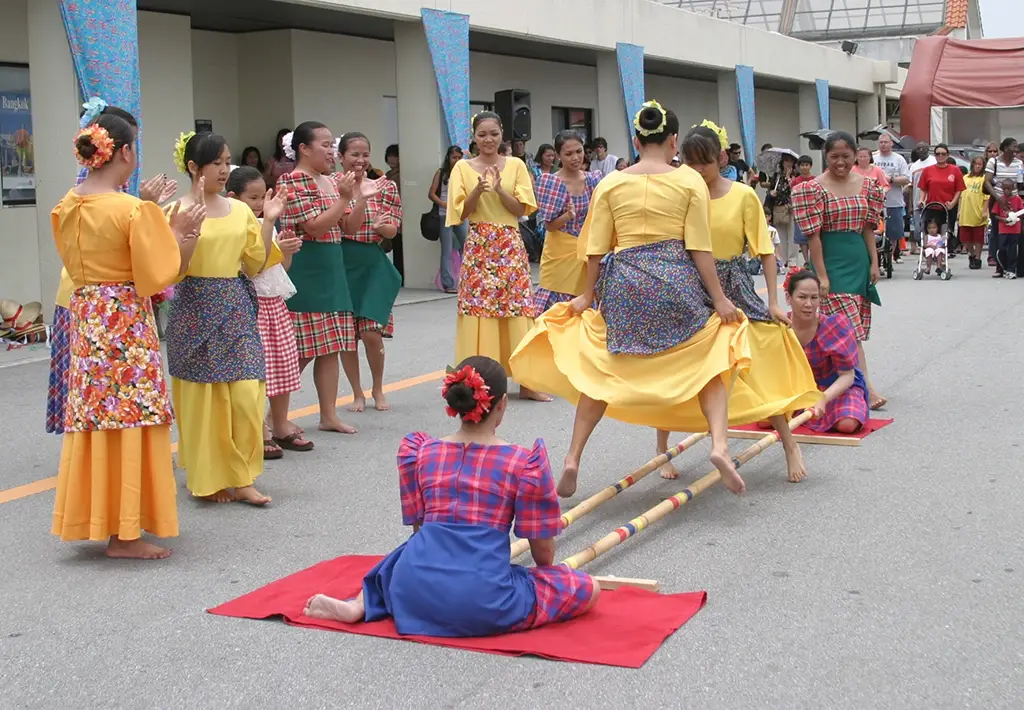
Dance in the Philippines is not just entertainment—it’s cardio with cultural meaning.
- Tinikling – You jump between rapidly clapping bamboo poles while pretending not to panic. It mimics the movements of the elusive tikling bird and tests your survival instincts. Bonus points if you don’t sprain your ankle.
- Singkil – A royal Maranao dance involving precision, storytelling, and gracefully dodging crisscrossed poles like an elegant ninja.
- Street Dances during Festivals – It’s less “TikTok dance” and more “synchronized, sequined explosion of joy,” performed in 40°C heat with full makeup. If that’s not devotion, what is?
Every dance step, hip sway, and arm flourish tells a story—usually involving gods, courtship, war, or mangoes. Probably mangoes. This is a living form of the Filipino heritage.
Brushstrokes and Battle Cries: Filipino Visual Art
Art in the Philippines is not just something you hang on a wall—it’s a whole vibe.
- Petroglyphs in Angono are like the country’s prehistoric group chat—messages carved in rock by ancient hands.
- During Spanish times, art primarily referred to religious paintings. Lots of saints. Lots of suffering. Very Baroque. Very dramatic.
- Enter Juan Luna’s Spoliarium—a 19th-century mic drop in oil paint. It screams colonial oppression in every stroke—heavy stuff. Bring tissues.
- Then there’s Fernando Amorsolo, who painted dreamy rural landscapes that made everyone wish they had a carabao and a rice field.
These days? Modern Filipino artists are blending ancestral stories with social commentary, pop culture, and—of course—lots of national colors because nothing says “Filipino pride” like a mural of José Rizal wearing shades.
Sacred Threads — Language, Literature, and Oral Lore
Because who needs Netflix when you’ve got epic poems and sassy scripts?
Baybayin: The OG Filipino Font
Before Comic Sans, before Helvetica, before “Live, Laugh, Love” stencils—Filipinos had Baybayin.
This pre-colonial script is all curves and curls and looks like someone wrote love notes while doing yoga. Used for poetry, legal stuff, and love letters etched on bamboo, Baybayin was the original “slide into my DM.”
The Spaniards tried to erase it. But surprise—it’s back. And now, it’s everywhere: T-shirts, tattoos, logos, and Instagram bios of people who’ve never actually read it. Still, we love the effort.
Epics, Myths, and a Whole Lot of Drama
Filipino oral literature is packed with more plot twists than your favorite K-drama. This is certainly a carry-over of the early Filipino heritage!
- Hinilawod from the Visayas? A ten-hour epic with magic boats, heroic bros, and divine interventions.
- Biag ni Lam-ang from the Ilocos? A guy gets born, walks, talks, fights giants, and marries a girl—all before you’ve had your second cup of coffee.
These stories weren’t just for fun. They were performed with gongs, chants, and flair during gatherings. Think of it as Netflix with no buffering.
Modern Writers and the Literary Mic Drop
The literary glow-up didn’t stop with oral tradition.
- Nick Joaquin wrote magical realism before it was cool.
- Lualhati Bautista tackled feminism and revolution in a country raised on telenovelas and tapa.
- Carlos Bulosan gave voice to overseas Filipinos long before TikTok tears and OFW confessionals.
Today, new writers are remixing old myths with memes, social issues, and multilingual poetry slams. Literature is alive, well, and probably running a podcast.
Feast for the Senses — Culinary Heritage of the Philippines
Because if there’s one thing Filipinos take seriously, it’s food. And family. And food again.
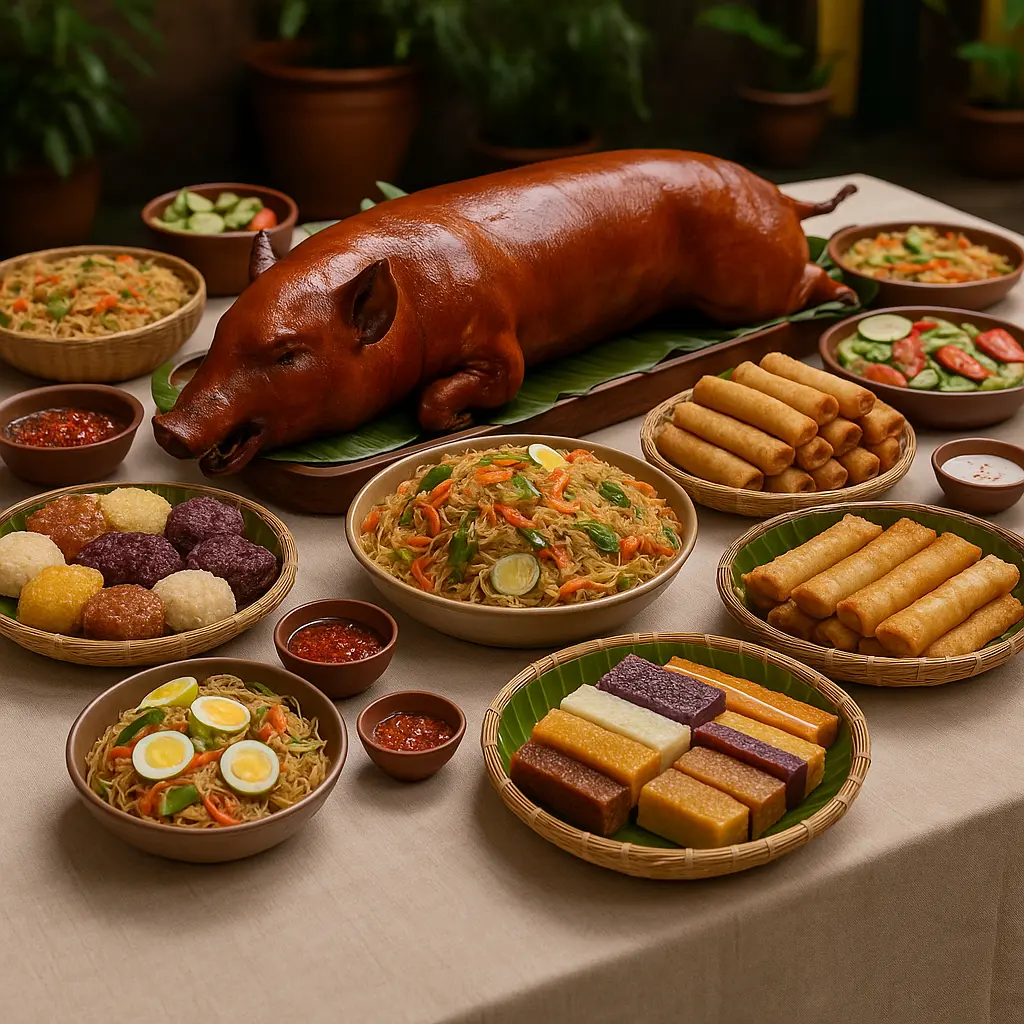
Regional Delights: 7,000 Islands, 7,000 Recipes (Give or Take)
Filipino cuisine is like a massive family reunion. Everyone brings their signature dish. No one agrees on who made it best. And someone’s lola is always judging in silence.
- Ilocos gives us bagnet—crispy pork so crunchy it should be illegal. And pinakbet—vegetables cooked like they owe you money.
- Pampanga is the culinary capital. They turned pork face (sisig) into poetry and made kare-kare (oxtail in peanut sauce) the star of every Sunday lunch.
- Bicolanos said, “Why not add chili to everything?” Enter Bicol Express and laing—spicy, coconut-creamy, and not for the weak of tongue.
- Mindanao offers flavors kissed by Muslim and Malay influence. Ever tried piaparan (chicken in coconut milk)? Or tiyula itum—a black soup with burnt coconut that tastes better than it sounds? Exactly.
Each region has its vibe, and its version of “you have to try this or you’re not a real Filipino.”
Fusion Cuisine: Colonization, But Make It Delicious
If food could talk, Filipino dishes would say, “I contain multitudes.”
- Spain gave us tomatoes, garlic, and the concept of putting everything in one pot (menudo, mechado, afritada—the holy trinity of meaty confusion).
- China brought pancit, lumpia, and the skill of feeding 12 people with one wok and a prayer.
- America introduced canned goods and hot dogs in spaghetti, which somehow became a national treasure. (Don’t fight it. Just eat.)
Filipinos didn’t just copy—they remixed. Now, every bite tells a story of survival, adaptation, and someone’s aunt insisting her adobo recipe is the only one that counts.
Food as a Love Language (and a Competitive Sport)
In the Philippines, “Have you eaten?” is code for “I love you,” “You look tired,” and “Let me feed you until you cry.”
- Fiestas mean lechon, pancit, five kinds of kakanin, and zero leftovers.
- Funerals have food.
- Baptisms have food.
- Random Tuesday? Still food.
Every family event involves an all-you-can-eat buffet followed by unsolicited gossip and plastic bags for leftovers. If you leave hungry, that’s on you.
Worship and Wonder — Spirituality and Religion
God is everywhere here, especially at karaoke.
Before There Were Churches, There Were Trees (and Lots of Spirits)
Once upon a time, Filipinos believed everything had a soul: rivers, rocks, mangoes, your cranky neighbor. This was animism, and it shaped how people lived, farmed, and asked permission before cutting down a tree.
Then came the Spaniards, swinging crosses and building churches faster than you can say “Ave Maria.” Catholicism took over, but Filipinos didn’t forget their roots. Instead, they made room on the altar for both saints and spirits. Because why not double your blessings?
In Mindanao, Islam arrived with traders, not conquerors. Mosques rose beside rice paddies, and faith took root peacefully. To this day, millions of Filipinos call Allah by name—with the same reverence their northern cousins give to Señor Santo Niño.
It’s a spiritual remix. Part rosary. Part ritual. All deeply Filipino.
Festivals: Where Faith and Confetti Collide
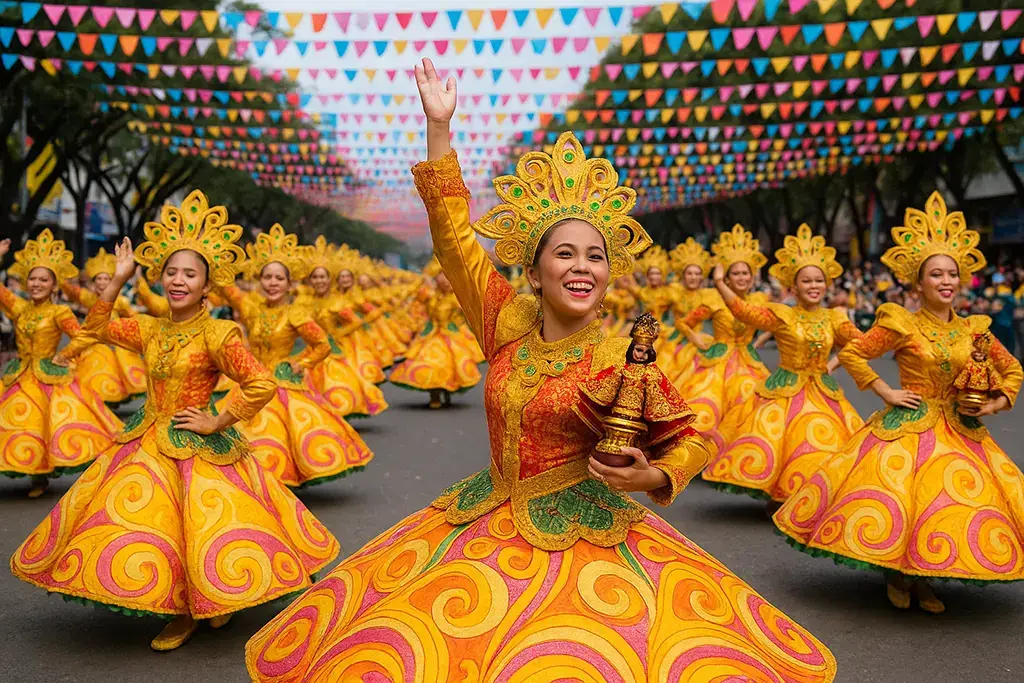
Filipino religious festivals are less “quiet reverence” and more “full-blown party for the Lord.” And they integrate the Filipino heritage, as well as the local heritage, into the celebration.
- Simbang Gabi: Nine dawn masses leading to Christmas. You go for Jesus. You stay for bibingka and puto bumbong.
- Sinulog: In Cebu, thousands dance in the streets shouting “Pit Señor!” in honor of the Holy Child, while wearing feathers, sequins, and probably sweating through three layers of costume.
- Eid al-Fitr & Eid al-Adha: In Muslim areas, the fast breaks with feasts, laughter, and family. It’s peace wrapped in banana leaves and shared with the entire neighborhood.
These festivals are spiritual, yes—but also joyful, loud, and often covered in glitter. In the Philippines, prayer is a full-body experience.
Sacred Spaces: Churches, Mosques, and Mountains with Better Views Than Your Hotel
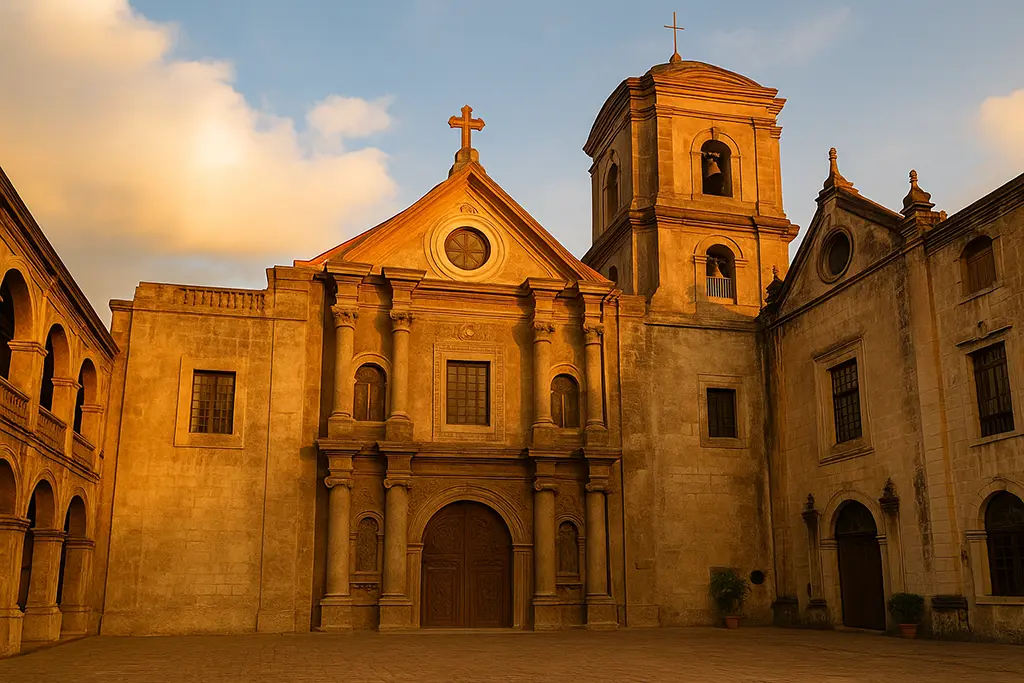
- San Agustin Church: The oldest stone church in Manila. Still standing. Still majestic. Probably haunted. 10/10 worth a visit.
- Sultan Haji Hassanal Bolkiah Mosque: A golden gem in Cotabato, glowing with Islamic devotion and serious architectural drip.
- Mount Apo: The tallest peak in the country and a spiritual pilgrimage site for indigenous groups. Warning: the views may cause sudden existential reflection.
You don’t need to believe in a specific faith to feel something here. The energy? Palpable. The reverence? Real. The Wi-Fi? Spotty, but who cares?
Threads of Identity — Traditional Clothing and Indigenous Weaves
When your outfit says, “I look amazing AND I carry 400 years of Filipino heritage.”
Weaving: Where Grandma is the Original Fashion Designer
Filipino weaving isn’t just a hobby—it’s art, storytelling, and spiritual flex rolled into one.
- Up in the Cordilleras, women weave inabel with such skill, you’d think they were born with looms attached. Patterns represent rice harvests, ancestors, and possibly how many cups of rice they had for lunch.
- In Mindanao, the T’boli women weave t’nalak—but only if they receive a dream from the weaving goddess Fu Dalu. Yes, dream weaving is real, and no, you can’t just fake it for likes.
- Materials? Oh, just casual fibers like abaca, piña, and cotton. They spin gold from leaves and time.
To wear these weaves is to wear a story. Also, to attract compliments and possibly start a lecture on cultural appropriation. So tread (or thread) respectfully.
The Barong Tagalog & Terno: Fashion That Fights Colonialism with Elegance

Let’s talk national drips.
- The Barong Tagalog: Sheer. Embroidered. Looks like formal wear, feels like pajamas. Initially enforced by colonizers so locals couldn’t hide weapons—but joke’s on them, we made it fashion. Now worn at weddings, inaugurations, and anytime you want to look presidential without sweating through a suit.
- The Terno: Think butterfly sleeves with a side of majesty. Worn by queens, beauty queens, and your aunt who always overdresses for Sunday lunch. It evolved from Spanish colonial styles, but Filipinas reclaimed it and said, “This is mine now—add glitter.”
Together, they’re more than outfits. They’re armor against time, erasure, and boring fashion choices.
Echoes in Stone — Architecture and Ancestral Homes
If these walls could talk, they’d spill more tea than your neighborhood chismosa.
Bahay Kubo: The Original Open-Concept Home
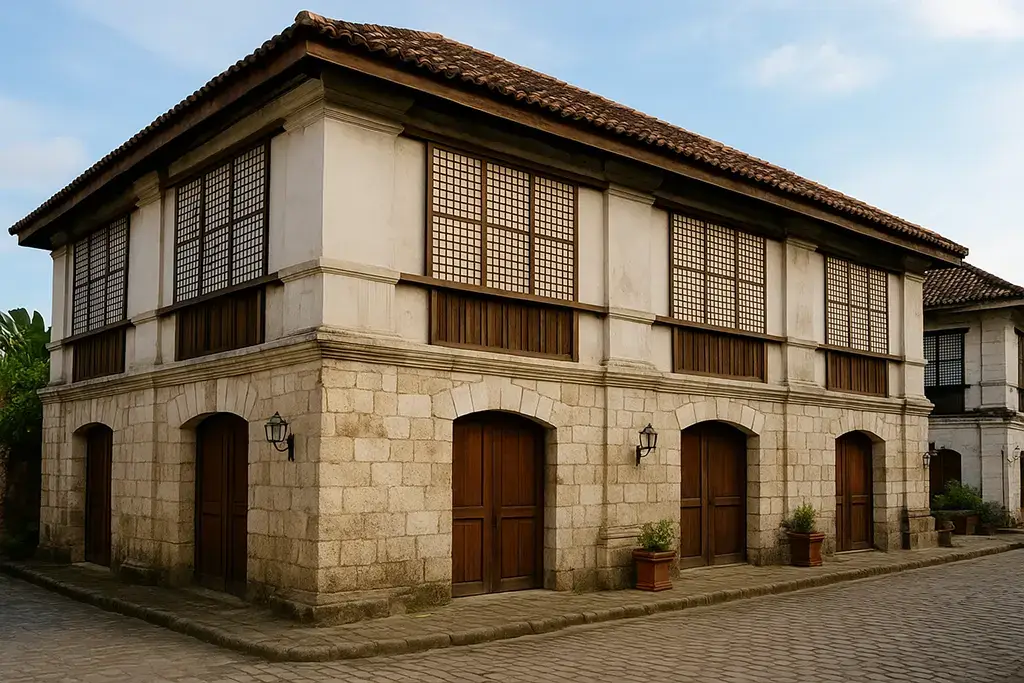
You know the song. You’ve seen the model in every souvenir shop. But the bahay kubo is more than a catchy tune—it’s sustainable design before it was trendy.
- Made of bamboo and nipa
- Raised on stilts to avoid floods and nosy neighbors
- Breathes with the wind, like your ex who thinks they’re deep
It’s proof that the best architecture doesn’t require a Pinterest board—just common sense and coconut leaves.
Bahay na Bato: Where Colonial Meets Filipino Realness
Now let’s level up to the bahay na bato, the colonial-era upgrade nobody asked for—but somehow everyone wanted.
- Stone foundation (for stability)
- Wood upstairs (for creaks and family drama)
- Capiz shell windows (for soft lighting and mood)
These homes saw revolutions, family feasts, and probably at least one ghost. They’re still standing in places like Vigan, whispering, “We’ve seen things… like Spanish landlords and questionable fashion.” This is where Filipino heritage is on proud display!
Walking into a preserved ancestral home feels like stepping into a history book, with its better furniture and even more authentic vibes.
Guardians of the Earth — Indigenous People and Ancestral Lands
They were here first. They know what they’re doing. Maybe we should listen?
The Lumad, Igorot, and Aeta: The OG Eco-Warriors
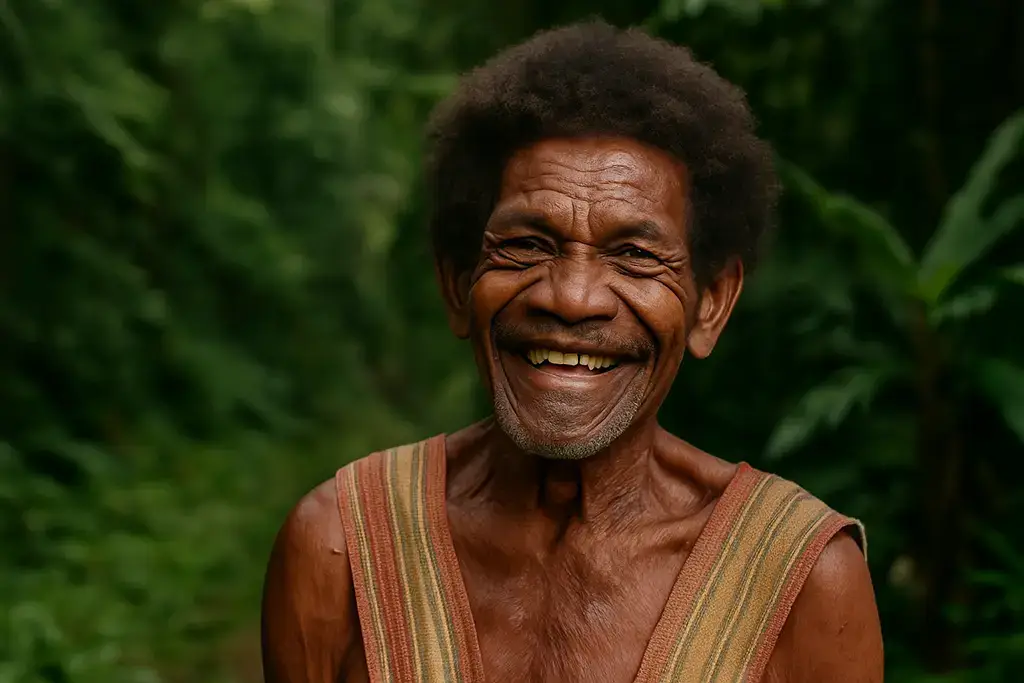
Before sustainability became a buzzword, these indigenous groups were already living it.
- The Lumad of Mindanao treat forests like family. Their songs are lullabies to rivers and trees. They don’t just use nature—they collaborate with it.
- The Igorot built rice terraces that have lasted longer than most governments. Their culture is carved into cliffs and sung to the skies.
- The Aeta, often called the original Filipinos, are mountain-dwellers, forest-whisperers, and wisdom-keepers. They don’t need GPS. The trees guide them.
They don’t just live on the land—they belong to it.
The Sacred Land: Fences Are Not Welcome Here
To outsiders, land is property.
To indigenous people, land is identity.
And yet, corporations keep trying to mine, log, and concrete over sacred ground like it’s a blank space on SimCity.
But these communities? Still standing, resisting, dancing in protest, and singing in defiance. You can’t evict a worldview.
The fight for ancestral lands isn’t just political—it’s personal, spiritual, and cultural. And every time they win a legal case, a forest breathes a little easier.
Festivals of Fire — Celebrations that Ignite the Filipino Spirit
Warning: may cause sudden urges to dance in public wearing feathers.
Panagbenga, Kadayawan, Ati-Atihan: More Than Just Party Mode
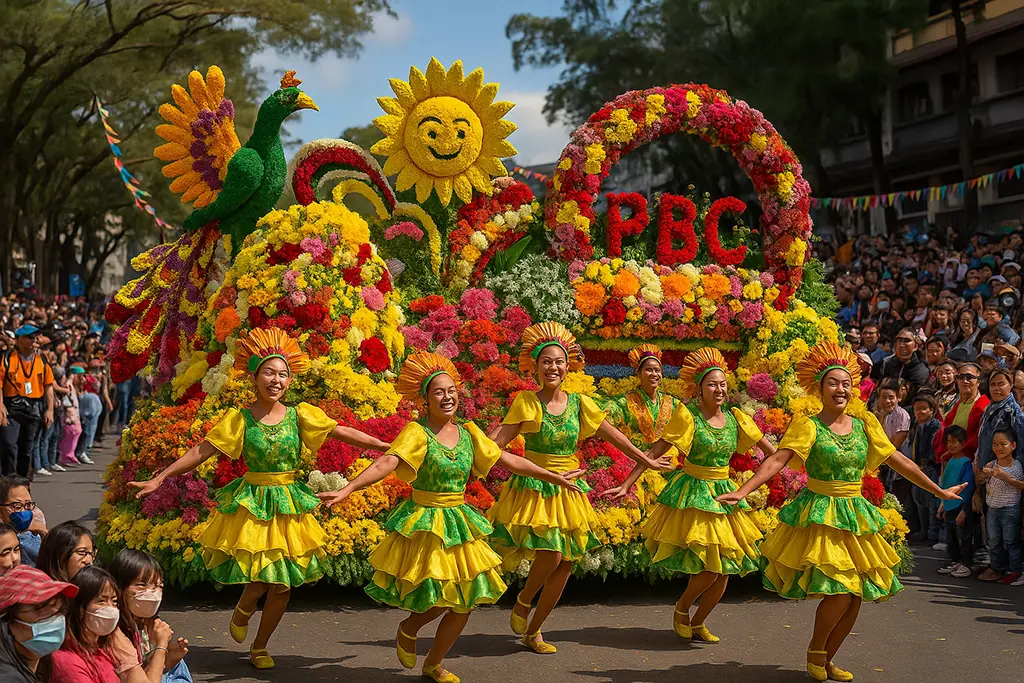
If there’s one thing Filipinos do better than karaoke, it’s throwing a festival.
- Panagbenga (Baguio): A flower festival that turns an entire mountain city into a botanical disco. Parade floats bloom with petals. Kids dance in sunflower costumes. Allergies? Worth it.
- Kadayawan (Davao): Eleven indigenous groups. One big “thank you” to the gods. Add fruit, tribal dance-offs, and costumes that belong on a Netflix fantasy series. It’s gratitude—and glitter—on steroids.
- Ati-Atihan (Aklan): Black body paint. Tribal beats. Shouting “Viva Señor Santo Niño!” while shaking maracas made of Sprite bottles. This is the OG fiesta—part devotion, part street rave, all heart.
Filipino festivals aren’t side events. They’re cultural main quests. And if you’ve never been dragged into an impromptu conga line led by a grandma in a sequin cape—have you even lived?
Heritage Preserved — Museums, Cultural Hubs, and National Treasures
Yes, you can learn history without falling asleep. Promise.
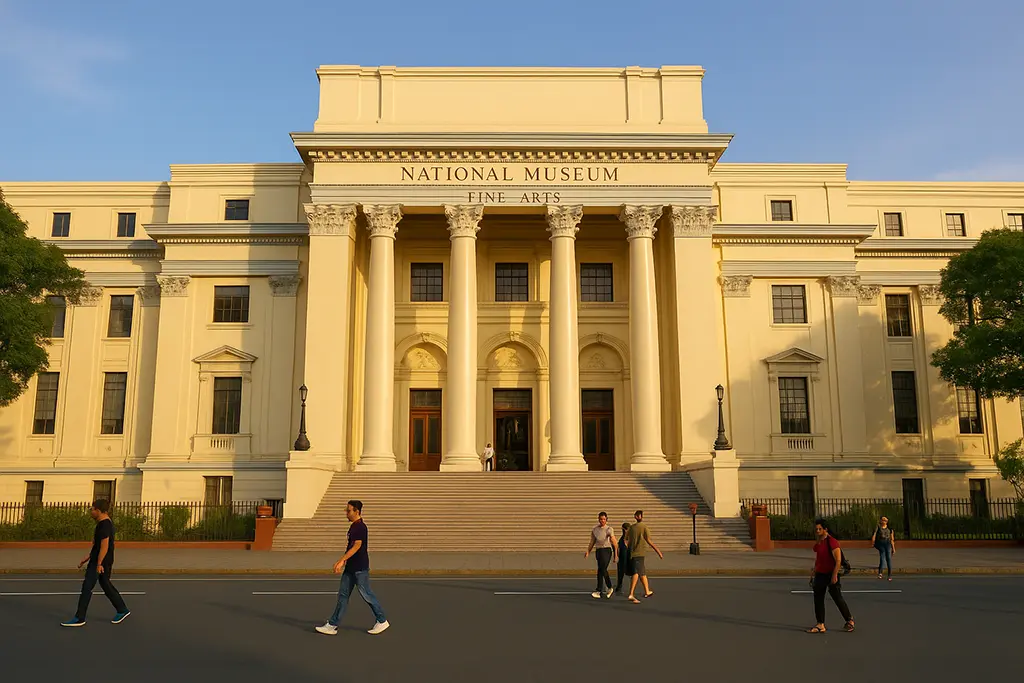
The National Museum Complex: Manila’s Most Educational Date Spot
In Manila sits a complex that has no rides, no mall, and no milk tea shops—and still slaps.
- The Spoliarium by Juan Luna is an oil-painting punch to the gut. It’s big. It’s dramatic. It’s got fallen gladiators and a side of “Down with colonialism!”
- Ancient jars? Check. Textiles that make fast fashion cry? Yep. Skeletons of extinct animals? Yes, and no, you can’t ride them.
And the air conditioning? Glorious. You’ll learn AND escape the heat—a true win-win.
Regional Museums: Small Towns, Big Stories
- Crisologo Museum (Vigan): It smells like old wood and revolution—10/10 ambiance.
- Negros Museum (Bacolod): Come for the sugar industry history, stay for the low-key class warfare undertones.
- Loboc Museum (Bohol): Where music, history, and riverboat nostalgia meet.
And don’t forget cultural centers like CCP and Sentro Rizal, where you can watch ballet and indigenous chants collide like it’s normal (because it is).
You’ll walk out smarter, prouder, and maybe suddenly become interested in collecting woven baskets.
The Living Legacy — Passing Culture to Future Generations
Because culture isn’t meant to be kept in a glass case. It’s intended to be passed around like pancit.
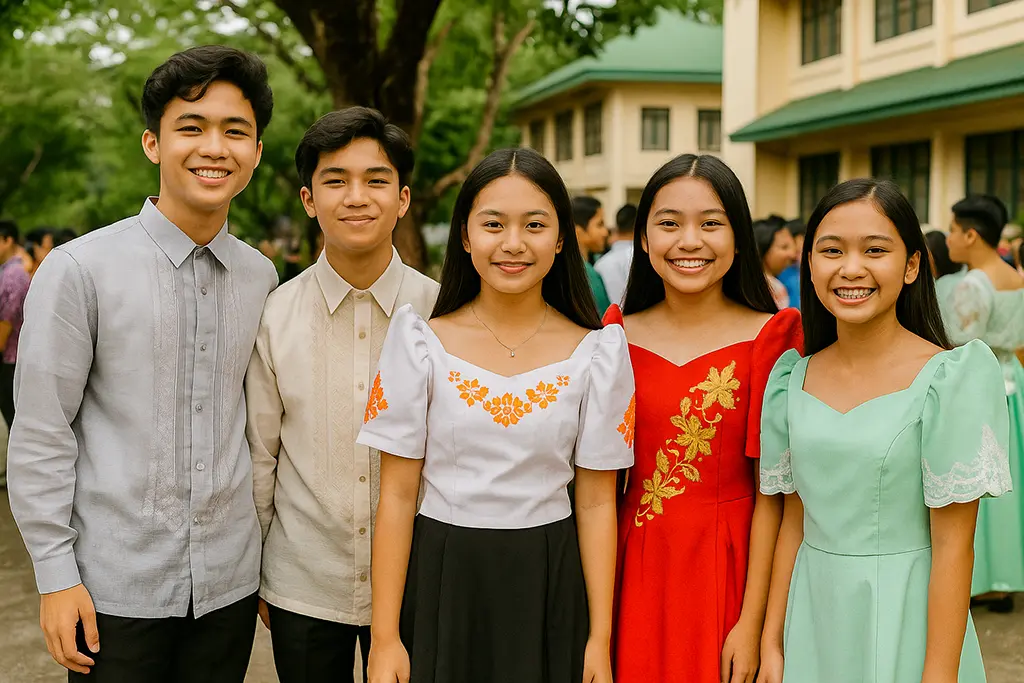
Education That Doesn’t Bore You to Death
It starts in classrooms, where kids now learn about Lapu-Lapu and Baybayin. About pre-colonial gold and pre-Magellan sass.
Teachers, parents, and community elders are bringing back dialects, dances, and even those long folk stories that somehow involve a talking crab and a clever banana tree.
Even TikTok’s doing its part. One minute it’s dance challenges, the next it’s a crash course in Filipino mythology—complete with filters and dramatic voiceovers.
The Youth Are Alright (And Amazing)
You thought culture would die with the internet? Nah. It just got a glow-up.
- Young people are wearing ternos to prom.
- They’re remixing kulintang beats into electronic music.
- They’re turning folk tales into graphic novels, indie films, and protest slogans.
They’re not forgetting. They’re evolving. And they’re carrying the culture into the future with Wi-Fi and wild imagination.
Conclusion: A Heritage That Breathes
The Philippines isn’t just a place. It’s a storybook written in many tongues, danced in bare feet, sung across mountaintops, fried in garlic, and worn with pride.
It’s a mixtape of ancestors, invaders, rebels, and dreamers—still playing, still loud.
To explore Filipino heritage is to laugh, cry, eat, dance, argue about adobo, and ultimately realize this: culture here isn’t locked away in a museum. It’s alive. Messy. Proud. And forever ready to welcome you with open arms and probably a plate of lumpia.
FAQs
1. What’s the best Filipino festival to attend?
The one you accidentally stumble into while buying snacks. But Sinulog, Ati-Atihan, and Kadayawan are solid bets for jaw-dropping vibes and sweaty, spiritual joy.
2. Why do Filipinos eat spaghetti with hot dogs?
Because we can. Also, colonialism, creativity, and a deep national desire for things that are sweet, weird, and slightly chaotic.
3. Can tourists visit indigenous communities?
Yes—but do it ethically. Book through responsible tour groups, respect local customs, and don’t treat anyone like a living museum exhibit.
4. How do I support Filipino culture as a foreigner?
Buy local. Learn a few Tagalog words. Respect traditions. And please, if someone’s lola offers you food, say yes.
5. Is Filipino culture really that diverse?
Imagine if 100+ languages, multiple colonizers, dozens of indigenous groups, and a karaoke machine had a child. That’s the Philippines.
Other Articles that may be of Interest
You may also find the following articles interesting.
- Warning: These 10 Reasons Will Make You Want to Travel the Philippines Immediately
- This Guide to the Philippines’ Most Beautiful Beaches Will Make You Quit Your Job
Suggestions For Lodging and Travel
Lodging is widely available throughout the Philippines. However, you may want to consider getting assistance booking tours to some of the Philippines’ attractions. I’ve provided a few local agencies that we’ve found to be very good for setting up tours. For transparency, we may earn a commission when you click on certain links in this article, but this doesn’t influence our editorial standards. We only recommend services that we genuinely believe will enhance your travel experiences. This will not cost you anything, and I can continue to support this site through these links.
Local Lodging Assistance
- Guide to the Philippines: This site specializes in tours throughout the Philippines, offering flexibility in scheduling and competitive pricing. I highly recommend them for booking local arrangements for a trip like this one. You can book flights and hotels through the Expedia link provided below.
- Hotel Accommodations: I highly recommend The Manila Hotel for a stay in Manila. I stay here every time I travel to the Philippines. It is centrally located, and many attractions are easily accessible from there. Intramuros and Rizal Park are within walking distance. I have provided a search box below for you to use to search for hotels (click on “Stays” at the top) or flights (click on “Flights” at the top). This tool will provide me with an affiliate commission (at no additional cost to you).
- Kapwa Travel is a travel company focused on the Philippines. It specializes in customizing trips to meet customers’ needs.
- Tourismo Filipino is a well-established company that has been operating for over 40 years. It specializes in tailoring tours to meet customers’ needs.
- Tropical Experience Travel Services – Tours of the Philippines: This company offers a range of tour packages, allowing you to tailor your trip to your preferences.
Lastly, we recommend booking international travel flights through established organizations rather than a local travel agent in the Philippines. I recommend Expedia.com (see the box below), the site I use to book my international travel. I have provided a search box below for you to use to search for flights (click on “Flights” at the top) or Hotels (click on “Stays” at the top). This tool will provide me with an affiliate commission (at no cost to you).